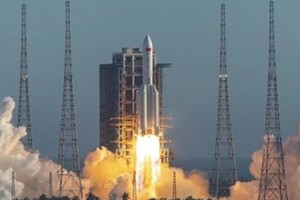The rocket launched a new module of the Chinese station into orbit.

Fragments of the massive Chinese Long March 5B missile, which has delivered a new module of the Chinese space station into orbit, may fall to Earth early next week, reports CNN with reference to the US Space Command.
Read also: Russia will still withdraw from the ISS project after 2024
The 23-ton launch vehicle launched from the spaceport in Hainan province on the morning of July 24. She coped with her task and began an uncontrolled movement towards the Earth's atmosphere. But where it will fall is unclear. This uncontrolled descent is already the third case when China has been accused of mishandling space debris, which was formed after the launch of a launch vehicle.
“This is a 20-ton metal object. Although it will break up as it enters the atmosphere, numerous pieces – some of them quite large – will reach the surface,” said Michael Byers, a professor at the University of British Columbia.
The scientist added that the risk to humans from space debris is minimal, but large fragments, if they fall in densely populated areas, can cause harm. According to Byers, due to the increase in the amount of space debris, such cases are becoming more likely. This is especially characteristic of the Global South, where the probability of a missile falling is three times higher than in other regions.
“This risk is completely avoidable because there are now technologies and mission designs that can provide controlled re-entries (usually into remote ocean areas) instead of uncontrolled and therefore completely random ones,” Byers added.
The U.S. Space Command said it will monitor the trajectory of the Chinese rocket as it approaches the Earth's atmosphere.
Given all possible weather conditions, the crash site “will not be determined within hours.” However, they are expected to enter the atmosphere on August 1.
Recall that China plans to complete the construction of its space station this year. From a single-module complex, it will turn into a structure consisting of three modules: the main “Tianhe” and two laboratory “Wenyang” and “Mentian”.
The first module was launched in April 2021, and the third is planned to be launched in October this year.
The first Taikonauts arrived at the station on June 17, 2021. Their task was to check the module's life support and maintenance system.




